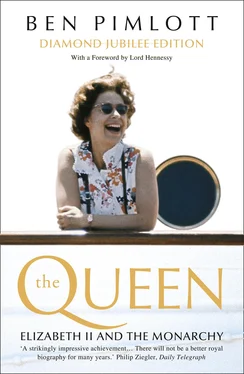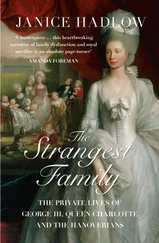In theory, the British Monarchy was already, and had long been, little more than a constitutional convenience. How could it be otherwise, with a Royal Family whose position had so frequently depended on parliamentary buttressing, or on a parliamentary decision to pass over a natural claimant in favour of a more appropriate minor branch? ‘If there was a mystic right in any one,’ as Walter Bagehot put it dryly in 1867, ‘that right was plainly in James II.’ 2Yet, in practice, there had been accretions of sentiment and loyalty which had allowed the obscure origins of the reigning dynasty to be forgotten. As a result, a traditional right or legitimacy had replaced a ‘divine’ one, and a great sanctity had attached to laws of succession unbroken for more than two centuries. The Abdication cut through all this like a knife – taking the Monarchy back as far as 1688, when Parliament had deprived a King of his throne on the grounds of his unfitness for it.
On that occasion, the official explanation was that James II had run away – though in reality there were other reasons for wishing to dispose of a monarch who caused political and sectarian division. In 1936, the ostensible cause of the King’s departure was his refusal to accept the advice of his ministers that he could not marry a divorced woman. Yet the Government’s position was also regarded as a moral, and not just a technical or legalistic one. The King’s relationship with Mrs Simpson was seen as symptomatic. The nation, as one commentator put it, took a dim view of tales of frivolity, luxury and ‘an un-English set of nonceurs ’, associated with the new King and minded seeing its throne ‘provide a music-hall turn for low foreign newspapers’. 3Although the decision to force Edward VIII to choose between marriage and his crown was reluctant, it was accompanied by a hope and belief that his successor – well-married, and with a family life that commanded wide approval – would set a better example.
But the Monarchy would never be the same again. ‘All the King’s horses and all the King’s men,’ Jimmy Maxton, leader of the left-wing Independent Labour Party, reminded the House of Commons, ‘could not put Humpty-Dumpty back again.’ 4Not only was the experience regarded, by all concerned, as chastening: there was also a feeling that, though the Monarchy would survive, it had been irrevocably scrambled. Even if George VI had possessed a more forceful character, the circumstances of his accession would have taken from the institution much of its former authority. As it was, the Monarchy could never again be (in the words of a contemporary writer) ‘so socially aggressive, so pushy’ as under George V; 5nor could it be so brash as under Edward VIII, whose arrival ‘hatless from the air,’ in John Betjeman’s words, had signalled a desire to innovate. After the Abdication, George VI felt a need to provide reassurance, and to behave with a maximum of caution, as if the vulgar lifting of skirts in the autumn of 1936 had never happened. Yet there could be no simple return to the old position of the Monarch as morally powerful arbitrator, a role played by George V as recently as 1931. Under George VI, royal interventions, even minor ones, diminished. The acceptance of a cypher-monarchy, almost devoid of political independence, began in 1936.
If the Abdication was seen as a success, this was partly because of an accurate assessment that the genetic dice had serendipitously provided a man who would perform the functions of his office in the dutifully subdued way required of him. Indeed, not only the disposition of the Duke of York but the familial virtues of both himself and his wife had been a key element in the equation. The point had been made by Edward VIII in his farewell broadcast, to soften the blow of his departure, when he declared that his brother ‘has one matchless blessing, enjoyed by so many of you and not bestowed on me – a happy home with his wife and children.’ 6It was also stressed by Queen Mary, when she commended her daughter-in-law as well as her second son to the nation. ‘I know,’ she said with feeling and with meaning, ‘that you have already taken her children to your hearts.’ 7Everybody appreciated that if the next in line had happened to be a footloose bachelor or wastrel, the outcome might have been very different. As it was, the Duke of York – despite, but perhaps also because of, his personal uncertainties – turned out to be well suited to the difficult task of doing very little conscientiously: a man, in the words of a contemporary eulogizer, ‘ordinary enough, amazing enough, to find it natural and sufficient all his life to know only the sort of people a Symbol King ought to know,’ and, moreover, one who ‘needs no private life different from what it ought to be.’ 8
To restore a faith in the Royal Family’s dedication to duty: that was George VI’s single most important task. There was a sense of treading on eggshells, and banishing the past. As the Coronation approached, the regrettable reason for the King’s accession was glossed over in the souvenir books, and delicately avoided in speeches. The monarchist historian Sir Charles Petrie observed a few years later that there was a tendency to forget all about it, ‘and particularly has this been the case in what may be described as official circles’. 9It was partly because the memory of the episode was acutely painful to the King and Queen, as well as to Queen Mary, but it was also because of the embarrassment Edward VIII’s abdication caused to the dynasty, and the difficulty of incorporating an act of selfishness into the seamless royal image. Burying the trauma, however, did not dispose of it, and the physical survival of the Duke and Duchess of Windsor – unprotected by a Court, and often teetering on the brink of indiscretion or indecorum – provided a disquieting shadow, reminding the world of an alternative dynastic story.
By contrast, the existence of ‘the little ladies of 145 Piccadilly’ gave the new Royal Family a trump card. If, in the eyes of the public, the Duchess of Windsor was cast as a seductress, the little ladies offered cotton-clad purity, innocence and, in the case of Princess Elizabeth, hope. It greatly helped that her virtues, described by the press since babyhood, were already well-known. What if she had inherited her uncle’s characteristics instead of her father’s? Fortunately the stock of attributes provided by the sketch-writers did not admit of such a possibility. The ten-and-a-half-year-old Heiress Presumptive, it was confidently observed, possessed ‘great charm and a natural unassuming dignity’. The world not only already knew, but already loved her, and hoped that one day she would ‘rule the world’s greatest Empire’ as Queen. 10
The discovery that she had become a likely future Monarch, instead of somebody close to the throne with an outside chance of becoming one, seems to have been absorbed by Princess Elizabeth gradually. Although her father’s accession, and the elimination of doubt about the equal rights of royal daughters, placed her first in line, it was not yet certain that she would ever succeed. When Princess Alexandrina Victoria of Kent was told of her expectations at almost precisely the same age in March 1830, she was reported by her governess to have replied ‘I will be good’. According to Lady Strathmore, when Princess Elizabeth received the news, she ‘was ardently praying for a brother’. 11It was still imaginable: the Queen was only thirty-six at the time of the Coronation in May 1937, and shortly before it a rumour spread that she was pregnant. 12Increasingly, however, a view of the future with Princess Elizabeth as Monarch was widely accepted. There was even some speculation that Elizabeth might be given the title of Princess of Wales. 13According to her sister, the change of status was something they knew about, but did not discuss. ‘When our father became King,’ recalls Princess Margaret, ‘I said to her, “Does that mean you’re going to be Queen?” She replied, “Yes, I suppose it does.” She didn’t mention it again.’ 14
Читать дальше












